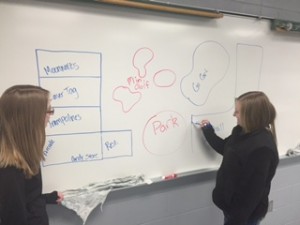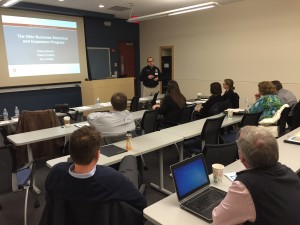With only a few weeks of school to go before graduation, Van Wert City School seniors were offered yet another option to consider for their future: becoming an entrepreneur and owning their own business.
Members of the Van Wert City Schools senior class are required to take Senior Government which includes a segment focused on Financial Literacy within the overall curriculum. The Financial Literacy portion of the class offers several aspects of personal finance, from car loans to credit cards. Missing in the program was an opportunity that involved owning your own business. Last year, Ohio State University Extension and the Wright State Lake Campus Business Enterprise collaborated with school administrators to teach students about starting their own business.
 With the program finishing its second year, Senior Government teacher, Bob Priest, was again impressed with the students’ interest and excitement about owning their own business. “Van Wert High School government students had the good fortune of participating with two universities at the local level for a three-day introduction to entrepreneurship, business planning and financing,” stated Priest. “I was impressed with the ideas the students created for the betterment of Van Wert, and then they had to put the numbers to their business plan. That was the difficult part. I think students now have a better understanding of how expensive and time consuming it can be to own a business.”
With the program finishing its second year, Senior Government teacher, Bob Priest, was again impressed with the students’ interest and excitement about owning their own business. “Van Wert High School government students had the good fortune of participating with two universities at the local level for a three-day introduction to entrepreneurship, business planning and financing,” stated Priest. “I was impressed with the ideas the students created for the betterment of Van Wert, and then they had to put the numbers to their business plan. That was the difficult part. I think students now have a better understanding of how expensive and time consuming it can be to own a business.”
The program involved personal entrepreneurship assessments, identifying local market opportunities, and creating a business plan. In addition to a visit from local entrepreneur and business owner of Firehouse Pizza in Middle Point, the students learned about start-up expenses, on-going operating costs, pricing and break-even analysis.
Post-program evaluation results indicated that 98% of the students felt the program was suitable for graduating seniors and 95% recommended Van Wert High School continue to offer the program. Surprisingly, 48% of the students responded they would be interested in owning their own business in the future. “Because of this, I may now think about starting my own business while I may not have wanted to before,” remarked one of the participating students.
(Submitted by Cindy Leis, County Extension Educator, Van Wert County & Maumee Valley EERA and Van Wert City Economic Development Director)



 Extension CD faculty
Extension CD faculty  It is something that we’ve all seen before. Some downtowns seem vibrant and full of life while others appear to be struggling to hold on. But why? In the United States, over 10 percent of all employed persons (more than 15 million people) are employed in the retail sector. In Ohio alone, over 650,000. While these employees provide a valuable service in retailing (who doesn’t like the hardware, bakery or jewelry stores?), the effects that a healthy retail sector can have on a community are immeasurable. So, what makes them work? We can learn more about this sector of a community’s economy via a Retail Market Analysis study.
It is something that we’ve all seen before. Some downtowns seem vibrant and full of life while others appear to be struggling to hold on. But why? In the United States, over 10 percent of all employed persons (more than 15 million people) are employed in the retail sector. In Ohio alone, over 650,000. While these employees provide a valuable service in retailing (who doesn’t like the hardware, bakery or jewelry stores?), the effects that a healthy retail sector can have on a community are immeasurable. So, what makes them work? We can learn more about this sector of a community’s economy via a Retail Market Analysis study.

 According to Johnson, to be prepared “The local team needs to understand that every facet of your site is quantitatively ranked and each industry, each project will rank you differently.” In other words, the local team needs to convey the unique things they have to offer each individual prospect and be able to prove it. Corporations are obsessed with “risk avoidance” which means the local team must remove any mystery or perceptions of risk.
According to Johnson, to be prepared “The local team needs to understand that every facet of your site is quantitatively ranked and each industry, each project will rank you differently.” In other words, the local team needs to convey the unique things they have to offer each individual prospect and be able to prove it. Corporations are obsessed with “risk avoidance” which means the local team must remove any mystery or perceptions of risk. Extension researchers recently shared the highlights of an advanced cluster analysis focused on manufacturing with community development officials in four EDD’s (economic development districts) within the eastern Ohio shale play. The cluster analysis is one of four analytical steps being conducted as part of an EDA (Economic Development Administration) funded project to inform the overall 25-county region about economic, social and environmental changes, potential implications and strategic directions for sustainable development.
Extension researchers recently shared the highlights of an advanced cluster analysis focused on manufacturing with community development officials in four EDD’s (economic development districts) within the eastern Ohio shale play. The cluster analysis is one of four analytical steps being conducted as part of an EDA (Economic Development Administration) funded project to inform the overall 25-county region about economic, social and environmental changes, potential implications and strategic directions for sustainable development.